Making the perfect pizza dough is both an art and a science. While the end goal is a pliable, stretchy base ready to cradle your favorite toppings, getting there can sometimes be a challenge.
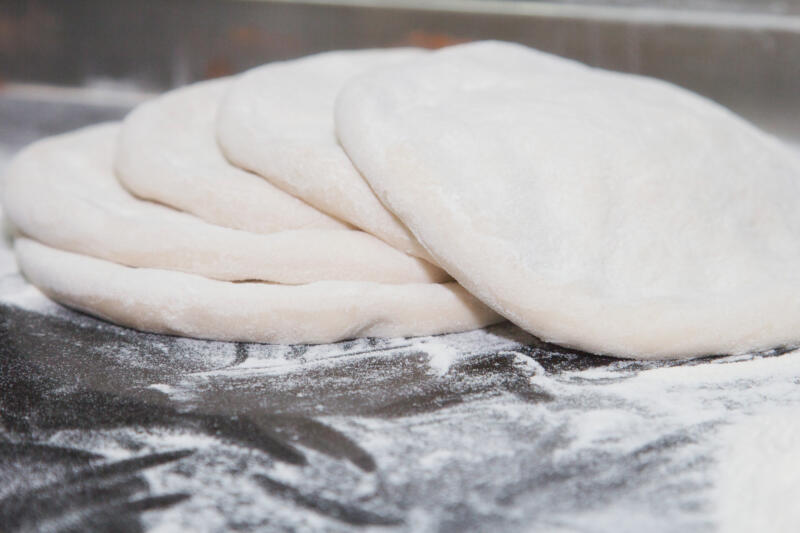
Many home cooks encounter the frustrating issue of dough that refuses to stretch, tearing easily, or shrinking back stubbornly.
This resistance can be attributed to a myriad of factors, from the dough’s temperature to its gluten development.
Understanding these nuances is crucial for anyone looking to master the art of pizza-making and avoid the pitfalls of uncooperative dough.
In this article, we’ve delved into the science behind pizza dough and why it might not stretch as you’d like.
In this article:
Defining Pizza Dough
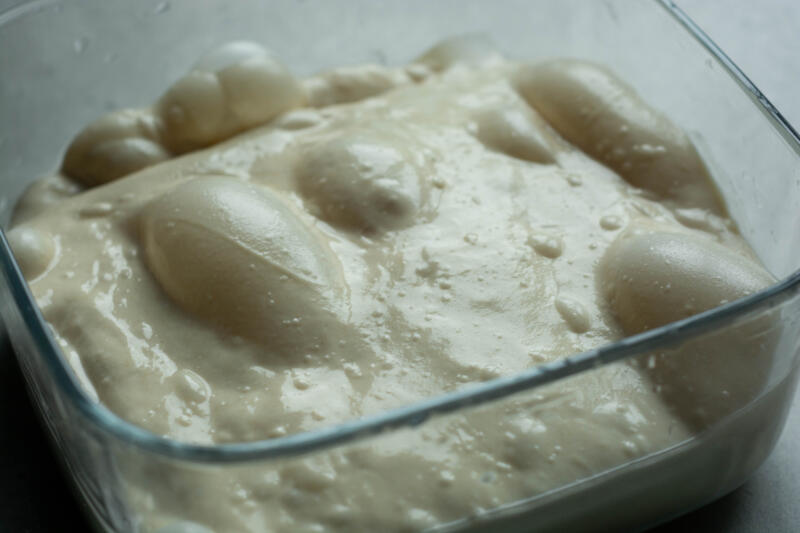
Pizza dough, the foundation of any great pizza, is a simple yet complex entity. Its composition is straightforward, typically consisting of flour, water, yeast, and salt.
However, the characteristics of pizza dough are where the magic truly lies.
Dough’ Elasticity
The elasticity of pizza dough is a key characteristic that distinguishes it from other types of dough.
It allows the dough to be stretched and shaped without tearing.
When you’re shaping your pizza base, you want a dough that’s pliable and stretchy, one that will yield to your touch and hold its shape once formed.
The elasticity of pizza dough is largely due to the development of gluten, a protein found in wheat flour.
When flour is mixed with water, the gluten proteins form a network that gives the dough its structure and elasticity.
Yeast
The role of yeast in pizza dough cannot be overstated. Yeast, a fungal organism, drives the fermentation process when crafting dough.
As the yeast consumes the sugars in the dough, it produces carbon dioxide gas. This gas is captured within the web of gluten, making the dough puff up and giving it its flexible nature.
The yeast plays a vital role in this process of making pizza, contributing to the dough’s rise and elasticity.
Reasons Why Pizza Dough Won’t Stretch
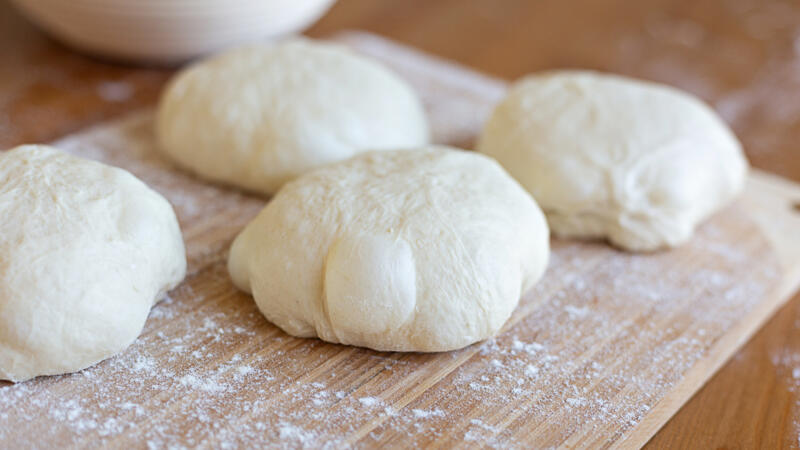
Despite the simplicity of its ingredients, achieving the perfect pizza dough can be a tricky process. There are several reasons why your pizza dough might not stretch as you’d like.
1. Dough’ Temperature
Cold dough is one of the top culprits. When dough is too cold, the gluten network tightens up, making it less elastic and more difficult to stretch.
The solution? Allow your dough to come to room temperature before you start working with it.
2. Improper Fermentation
Improper dough fermentation can also lead to a dough that won’t stretch. If the yeast doesn’t have enough time to work its magic, the dough won’t rise properly and will lack elasticity.
To fix this, ensure your dough has ample time to ferment, usually a few hours at room temperature or overnight in the fridge.
Moreover, some pizza dough recipes, especially those for Neapolitan and Sicilian pizzas, may call for a long fermentation process that can last up to 72 hours or even longer.
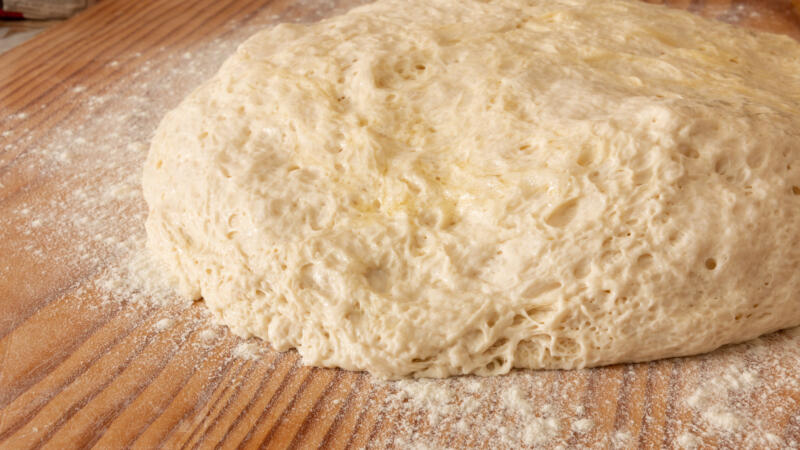
This extended fermentation period allows for a more complex flavor development and contributes to the dough’s texture and elasticity. It also aids in the dough’s digestibility.
3. Overworking the Dough
Poor dough handling can also contribute to a lack of stretch.
Overworking the dough can cause the gluten network to tighten up, making it harder to shape.
Handle your dough gently and minimally to maintain its elasticity.
4. Type of Flour
The protein content in your flour can also affect the elasticity of your dough.
High-protein flours create a stronger gluten network, which can make the dough more elastic.
On the other hand, cake flour or pastry flour is not typically used for pizza dough as they create a softer, more crumbly texture that doesn’t stretch well.
Play around with different flour options to determine the one that suits your needs best.
5. Humidity and Temperature
Dough behaves differently under varying environmental conditions, so you may need to adjust your recipe or technique accordingly.
For instance, in a high-humidity environment, flour absorbs more moisture, which can make the dough stickier and harder to handle.
You may need to add a bit more flour to achieve the right consistency.
Conversely, in a low-humidity environment, dough can dry out quickly, so you might need to add more water or cover the dough to prevent it from drying out.
Temperature also plays a crucial role. Yeast activity is sensitive to temperature, with warmer temperatures speeding up fermentation and colder temperatures slowing it down.
Therefore, if your kitchen is particularly warm, you may need to reduce the fermentation time to prevent the dough from over-proofing.
If it’s cold, you might need to allow more time for the dough to rise.
To address these issues, remember to let your dough come to room temperature before working with it, give it enough time to ferment, handle it gently, choose your flour wisely, and adjust for your specific environmental conditions.
Types of Flours Used for Pizza Dough
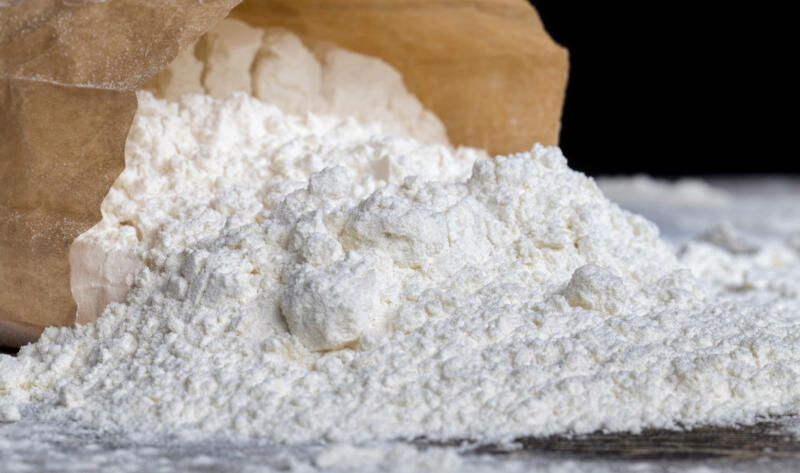
Selecting the appropriate flour is essential for crafting the perfect pizza dough. The type of flour you use can significantly impact the texture, elasticity, and flavor of your dough.
Bread Flour
Bread flour, which typically has a protein content of around 12-14%, is often used for pizza dough because it creates a sturdy yet stretchy dough.
This high protein content leads to a higher gluten development, which in turn gives the dough its characteristic elasticity and chewiness.
The texture of bread flour is coarser compared to other types of flour, and it absorbs more water.
This results in a dough that’s easy to handle and stretch, and it also contributes to a robust flavor that’s perfect for pizza.
If bread flour is not available, you can substitute it with other high-protein flours such as all-purpose flour with a protein content of around 10-12%, can also be used and may result in a slightly softer dough.
All-Purpose Flour
All-purpose flour is a versatile option for pizza-making, although it may not always be the first choice for purists.
This type of flour typically has a protein content ranging from 10% to 12%, which determines its gluten-forming potential.
Gluten, the protein network that forms when flour is mixed with water, is crucial for the dough’s elasticity and structure.
While ’00’ flour or bread flour might have a slightly higher protein content, making them ideal for super-elastic pizza doughs, all-purpose flour still offers a respectable amount of gluten.
The result is a balanced dough that’s pliable enough for stretching yet sufficiently sturdy to hold toppings.
For the everyday home cook, all-purpose flour provides a reliable and readily available option for delicious homemade pizzas.
00 Flour
There’s also 00 flour, a finely ground Italian flour that’s traditionally used for pizza dough in Italy. It has a protein content similar to all-purpose flour but is milled to a finer texture, which can make the dough easier to stretch.
Wheat Flour
Wheat flour has a higher gluten content than all-purpose flour (13%), which can lead to a dough with good elasticity.
However, the presence of the wheat’s bran and germ can result in a tougher crust compared to dough made with bread flour or all-purpose flour.
Using wheat flour can also impart a distinct, nutty flavor to your pizza dough, which some people enjoy.
However, keep in mind that such a flavor might not resonate with everyone.
Wrong Flours
Not all flours are suitable for making pizza dough. Flours with low protein content, such as cake flour or pastry flour about 7-9%, can lead to improper gluten development.
This can result in a dough that’s difficult to stretch and lacks the desired chewy texture.
Using the wrong type of flour can also affect the flavor of your pizza dough.
For instance, using a flour with a high protein content like bread flour or high-gluten flour will yield the best results in terms of both texture and flavor.
Tips to Make Perfect Homemade Pizza Dough That Will Stretch Easily
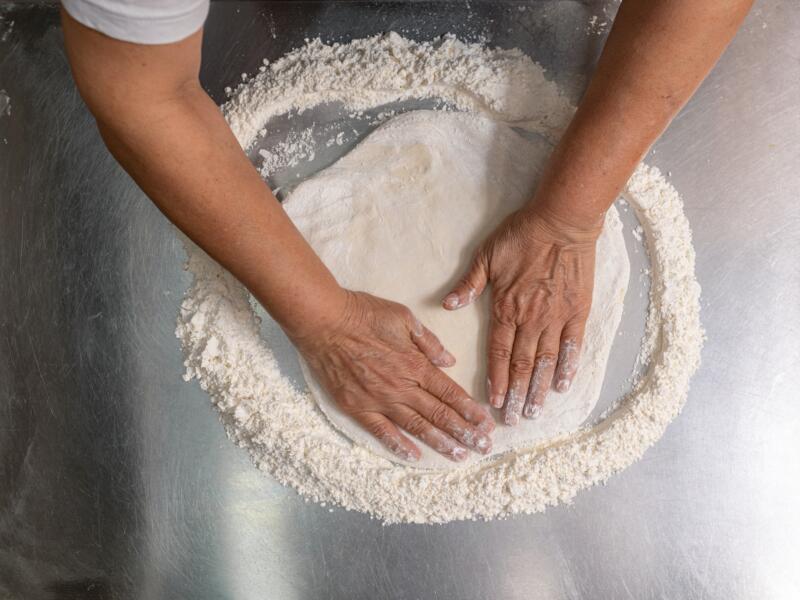
Creating the perfect pizza dough doesn’t stop at choosing the right flour or maintaining the correct temperature and hydration level.
There are additional steps you can take to ensure your dough is just right.
1. Preparing the Right Amount of Cold Water and Yeast for the Recipe
The first step in making pizza dough is to properly prepare the water and yeast.
Make sure your dough has sufficient moisture. The amount of water in the dough affects its ability to stretch and expand. Typically, dough with higher hydration will stretch more easily.
Using cold water to hydrate the flour helps control the fermentation process, ensuring that the yeast doesn’t activate too quickly.
It’s also important to add the yeast in the correct amount to develop the gluten properly.
A kitchen thermometer can be a handy tool to measure the temperature of the water.
To effectively activate yeast, the water should be within a temperature range of 100°F to 110°F (37°C to 43°C). Overly hot water risks destroying the yeast, whereas water that’s too cool may not stimulate it adequately.
2. Carefully Rolling Out the Original Shape
When it comes to shaping your pizza dough, gentle handling is key.
Start by forming a dough ball, then use a rolling pin to carefully roll out the dough to your desired size.
Proper kneading involves a combination of pressing, folding, and turning the dough.
This process should be repeated until the dough is smooth and elastic.
Be careful not to overwork the dough, as this can cause the gluten network to tighten up and make the dough less stretchy.
3. Resting the Dough
One crucial step is resting the dough before stretching. After kneading, the gluten network in the dough needs time to relax.
Letting the dough rest aids in its flexibility and moldability. If you rush and try to shape it right after kneading, it may resist and retract.
A rest period of about 10 to 15 minutes should suffice.
4. Working on a Hot Surface or a Hot Plate When Stretching Out Neapolitan Pizzas
If you’re making Neapolitan pizzas, working with a hot surface or a hot plate can be beneficial.
A hot surface, such as a pizza stone, can help achieve the right crust and texture for your pizza dough.
It provides a high, even heat, which is essential for getting that perfect, crispy crust. Just be sure to handle the hot surface with care to avoid any burns.
5. Oil Sprinkle
Finally, the role of oil in pizza dough is often overlooked, but it can significantly affect the dough’s texture and elasticity.
Adding a small amount of olive oil to the dough can make it softer and more pliable, making it easier to stretch.
Additionally, oil can help to create a crispier crust when the pizza is baked.
By incorporating these additional tips into your pizza dough preparation, you can ensure your dough is perfect every time.
Closing Thoughts
We’ve covered a lot of ground in this article, from the composition of pizza dough to the importance of gluten development and the role of different types of flour.
Understanding these factors can help you troubleshoot when your pizza dough is not stretching as it should.
Remember, pizza making is as much an art as it is a science. It takes practice, patience, and a bit of experimentation.
So, don’t be disheartened if your dough doesn’t come out perfect the first time.
Keep practicing, keep exploring, and above all, relish the journey.
After all, even a pizza that’s not quite perfect is still pretty delicious.
Do you have any questions or comments? Or perhaps some pizza dough tips of your own to share? We’d love to hear from you!